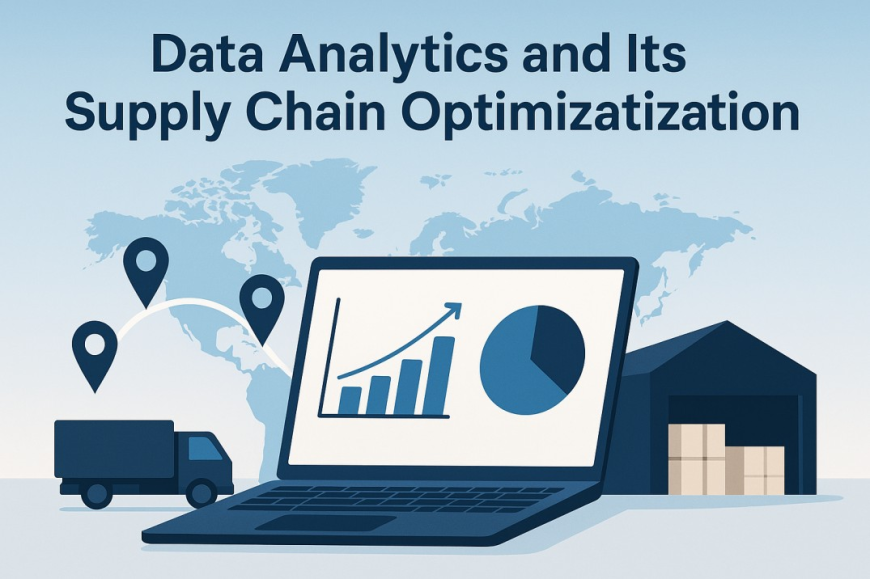Data Analytics and Its Role in Supply Chain Optimization
Learn how data analytics plays a key role in optimizing supply chains by improving efficiency, reducing costs, and boosting performance.

As businesses adapt to a tech-driven landscape, data analytics is transforming supply chains by boosting efficiency and optimizing operations at every level. With global markets becoming increasingly competitive, companies are under constant pressure to deliver faster, reduce costs, and maintain resilience across their supply chain operations. This is where data analytics steps in as a transformative force.
From improving forecasting accuracy to minimizing delivery delays, data-driven supply chains are the future. In this article, we’ll explore how data analytics is reshaping supply chain optimization and why it’s become a must-have for modern businesses.
What is Supply Chain Optimization?
Supply chain optimization involves making strategic improvements across the entire chain—from sourcing and production to warehousing, logistics, and customer delivery. The goal? Reduce costs, improve service quality, and adapt quickly to changing conditions.
While traditional supply chain management relied on manual reporting and reactive decisions, today’s environment demands a proactive, data-first approach—and that’s where analytics makes a major impact.
The Role of Data Analytics in Supply Chain Management
1. Demand Forecasting with Precision
One of the most powerful applications of data analytics is in demand forecasting. By analyzing historical sales data, seasonal trends, social media sentiment, and even weather patterns, businesses can accurately predict demand spikes and troughs.
This leads to:
-
Reduced stockouts and overstocking
-
More efficient procurement and production planning
-
Higher customer satisfaction
2. Smarter Inventory Management
Data analytics enables real-time visibility into inventory across multiple locations. With this, companies can:
-
Track product movement
-
Identify dead stock or fast-moving items
-
Automate reorder points
-
Reduce warehousing costs
By integrating predictive analytics, businesses can prevent excess inventory while ensuring they’re never caught off guard by demand fluctuations.
3. Enhancing Supplier and Vendor Relationships
Supplier reliability is crucial for seamless operations. Analytics allows you to measure performance indicators such as:
-
Delivery timeliness
-
Order accuracy
-
Pricing trends
-
Quality control issues
With this data, businesses can renegotiate contracts, diversify supplier networks, or strengthen relationships with top-performing vendors.
4. Optimizing Transportation and Logistics
Transportation is one of the largest cost centers in the supply chain. With real-time tracking and analytics tools, businesses can:
-
Optimize delivery routes
-
Reduce fuel consumption
-
Predict delays and proactively manage them
-
Improve last-mile delivery efficiency
Major logistics players like FedEx and Amazon use these models to maximize productivity and reduce costs.
5. Mitigating Risks Proactively
From geopolitical instability to pandemics, supply chains are always vulnerable to disruption. Data analytics helps mitigate risks by:
-
Running “what-if” simulations
-
Monitoring global news and market conditions
-
Detecting early warning signs in supplier behavior
This insight allows businesses to create contingency plans, adjust sourcing strategies, and stay ahead of disruptions.
6. Improving the Customer Experience
At the end of the day, supply chains exist to serve the customer. With analytics, companies can personalize experiences by:
-
Forecasting delivery timelines
-
Sending proactive order updates
-
Speeding up return and refund processes
-
Analyzing customer feedback to improve service
All of this leads to higher loyalty and a stronger brand image.
Real-World Applications: Who’s Doing It Right?
Unilever uses AI-driven analytics to track inventory across global warehouses, helping reduce waste and improve replenishment strategies.
Amazon leverages machine learning algorithms to predict demand and optimize logistics, giving them one of the most agile supply chains in the world.
DHL integrates IoT and analytics to monitor fleet performance and delivery success rates in real time, helping reduce downtime and boost delivery speed.
The Rise of Data Skills in Supply Chain Roles
As more businesses realize the potential of analytics, there’s a growing demand for skilled professionals who can harness this data and turn it into action. That’s why we’re seeing a surge in Data Analytics Training in Noida Delhi Lucknow Nagpur and other cities in India, where professionals are upskilling to stay relevant in this data-driven age.
Whether you’re a supply chain manager, analyst, or operations executive, learning how to work with tools like Power BI, Python, R, or machine learning platforms can make a significant difference in your career—and your company’s performance.
Tools Powering the Data-Driven Supply Chain
Here are a few technologies and platforms enabling supply chain analytics today:
-
ERP & SCM Platforms: SAP, Oracle, NetSuite
-
BI Tools: Power BI, Tableau, Qlik
-
Big Data & AI Tools: Python, Hadoop, Spark, Azure ML
-
IoT Devices & RFID: For real-time tracking and automation
Combining these tools gives companies a powerful tech stack to make data-driven decisions faster and more accurately.
Challenges to Watch Out For
Even with all the benefits, implementing data analytics isn’t without hurdles:
-
Data Silos: Information trapped in isolated systems
-
Data Quality: Inaccurate or outdated data can mislead decision-making
-
Lack of Expertise: Companies often struggle to hire skilled data professionals
-
Cost of Implementation: Software and training can require a significant initial investment
Still, with a clear strategy, the ROI of data analytics in supply chains far outweighs these initial roadblocks.
Final Thoughts
Data analytics is no longer a buzzword—it’s a critical business asset. From better forecasting and leaner inventory to smarter logistics and improved customer service, data is the thread that holds modern supply chains together.
Businesses investing in the right analytics tools—and the right talent—are seeing improved efficiency, cost savings, and resilience. And as training programs and courses become more widely available, especially in growing tech hubs across the country, data analytics is becoming accessible to professionals at all levels.
Source url: https://www.apsense.com/article/844786-data-analytics-and-its-role-in-supply-chain-optimization.html


 khushnuma123
khushnuma123 

